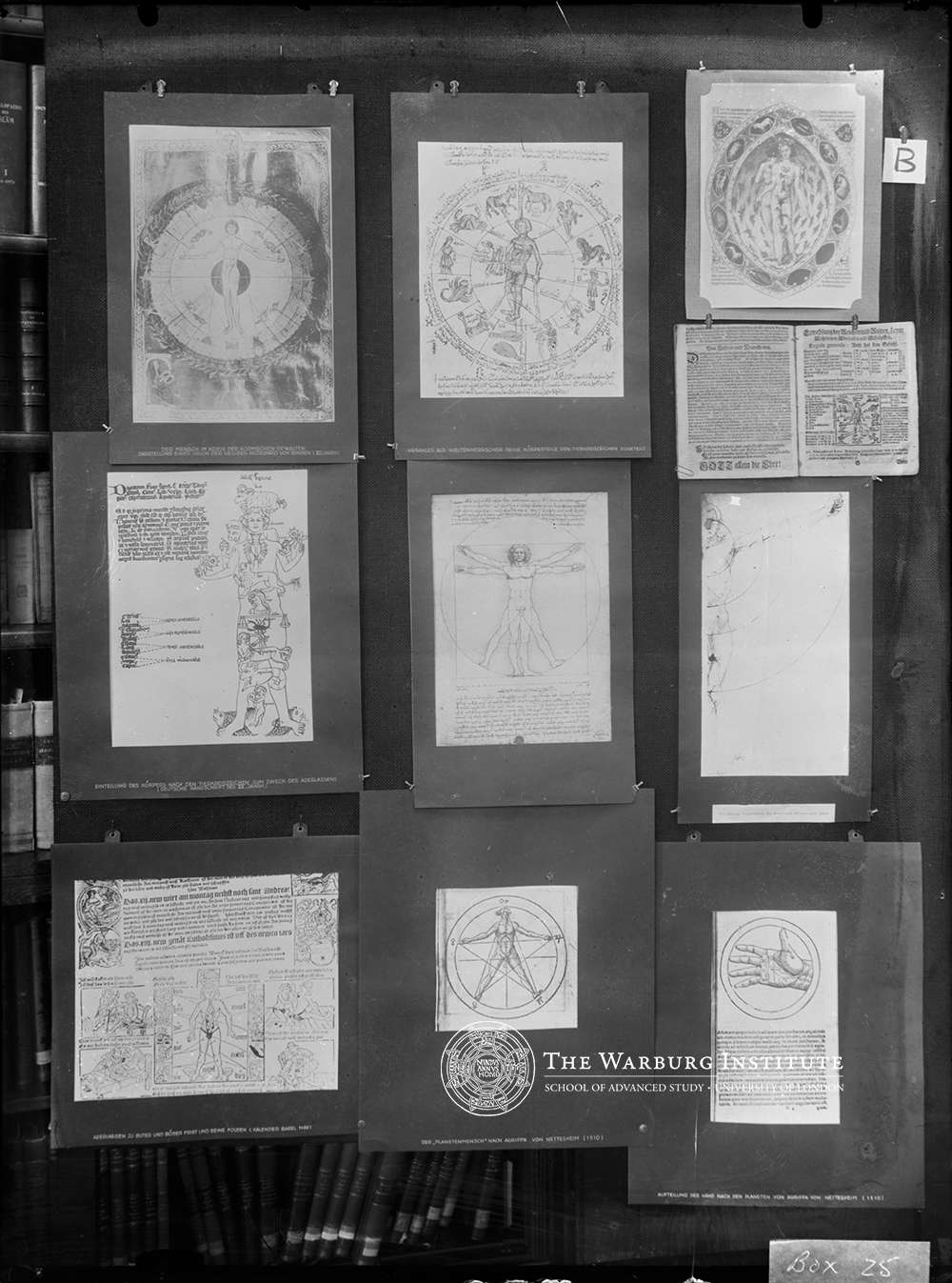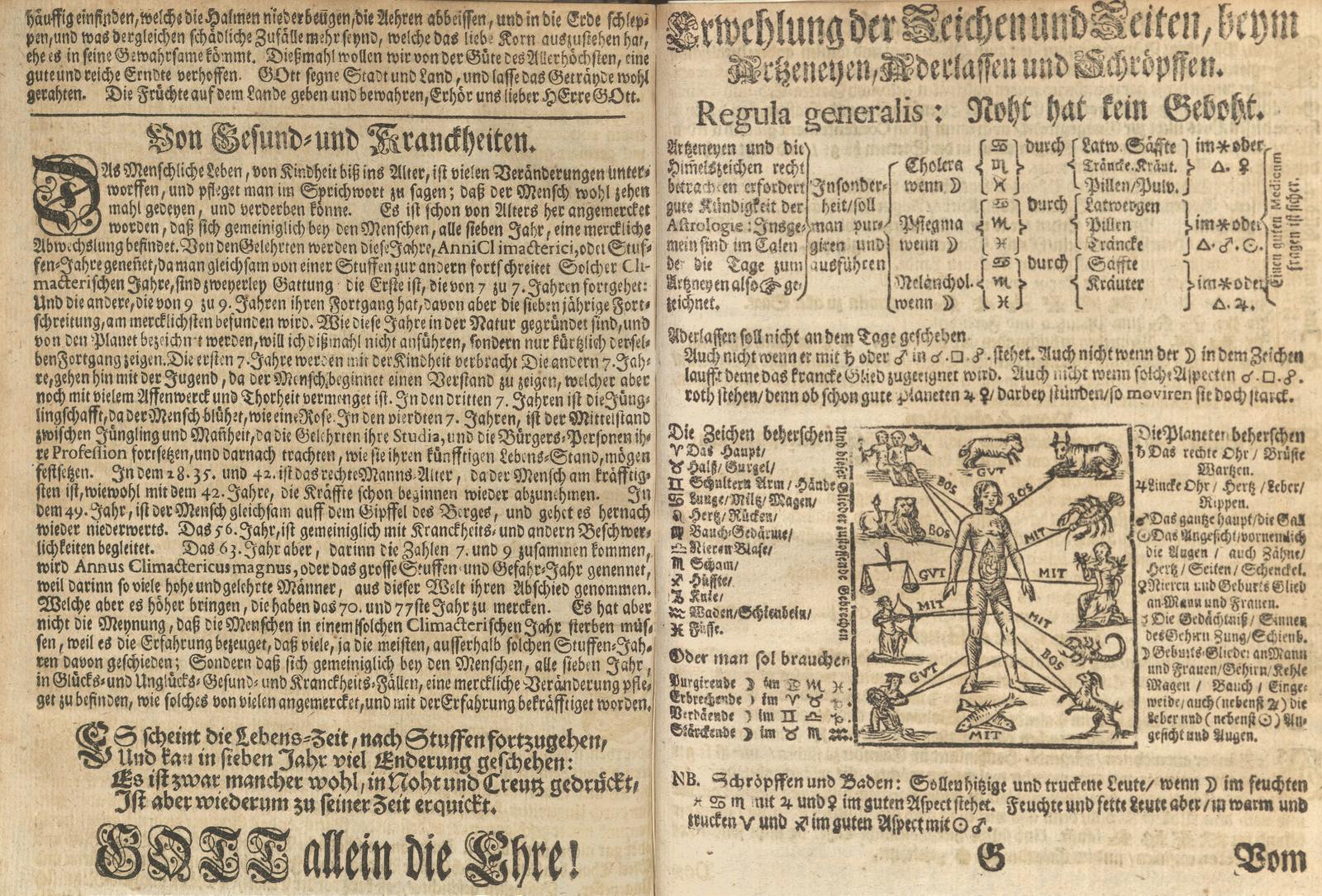Mnemosyne Atlas B
Dal cosmo all’uomo, e ritorno
L’esigenza umana di rappresentazione e di relazione con il cosmo si esprime in proiezioni di immagini e in influssi del cosmo sull’uomo: si istituisce una corrispondenza armonica tra sistema-cosmo e sistema-uomo. Nel Rinascimento questo schema di relazione armonica viene rappresentato in modo logico-geometrico (Leonardo) oltre che magico-demonico.
From the Cosmos to Man and back
Human need for representation of and connection with the cosmos is expressed in the projection of images and influences of the cosmos on Man: a harmonic connection between cosmos and man is established. During the Renaissance this harmony is represented logically and geometrically (Leonardo da Vinci), as well as magically and daemonically.

Appunti di Aby Warburg (1929)
Mikrokosmos
Microcosmo.
Appunti di Aby Warburg e collaboratori (1929)
Verschiedene Grade der Abtragung des kosmischen Systems auf den Menschen. Harmonikale Entsprechung. Später Reduktion der Harmonie auf die abstrakte Geometrie statt auf die kosmisch bedingte (Lionardo).
Diversi gradi di influenza del sistema cosmico sull'Uomo. Corrispondenze armonicali. In seguito, riduzione dell’armonia alla geometria astratta invece che a quella determinata cosmicamente (Leonardo).
Letture di approfondimento
♦ Seminario Mnemosyne, Dal cosmo all'uomo e ritorno: lettura di Tavola B dell'Atlante Mnemosyne, “La Rivista di Engramma” 138, settembre/ottobre 2016, 27-44; una prima versione: “La Rivista di Engramma” 10, luglio 2001 | “La Rivista di Engramma” 34, giugno/luglio 2004, 31-42.
♦ Seminario Mnemosyne, Iter per labyrinthum: le Tavole A B C. L’apertura tematica dell’Atlante Mnemosyne di Aby Warburg, “La Rivista di Engramma” 125, marzo 2015, 6-17; un primo compendio in “La Rivista di Engramma” 12, novembre 2001, 49-56.
♦ Seminario Mnemosyne, Letture grafiche di Tavola B, “La Rivista di Engramma” 34, giugno/luglio 2002; un primo compendio: “La Rivista di Engramma” 10, luglio 2001 [IMPAGINAZIONE ORIGINALE].
Notes by Aby Warburg (1929)
Mikrokosmos
Microcosmos.
Notes by Aby Warburg and coll. (1929)
Verschiedene Grade der Abtragung des kosmischen Systems auf den Menschen. Harmonikale Entsprechung. Später Reduktion der Harmonie auf die abstrakte Geometrie statt auf die kosmisch bedingte (Lionardo).
Different degrees in the application of the cosmic system to mankind. Harmonic correspondence. Later reduction of harmony to abstract rather than cosmically contingent geometry (Leonardo).
Further Readings
♦ Seminario Mnemosyne, Dal cosmo all'uomo e ritorno: lettura di Tavola B dell'Atlante Mnemosyne, “La Rivista di Engramma” 138, settembre/ottobre 2016, 27-44; previous versions: “La Rivista di Engramma” 34, giugno/luglio 2004, 31-42; “La Rivista di Engramma” 10, luglio 2001.
♦ Seminario Mnemosyne, Through the Maze: Plates A B and C. The opening themes of Aby Warburg’s Mnemosyne Atlas, English translation by E. Thomson, “La Rivista di Engramma” 125, marzo 2015, 18-29; a first compendium in “La Rivista di Engramma” 12, novembre 2001.
♦ Seminario Mnemosyne, Letture grafiche di Tavola B, “La Rivista di Engramma” 34, giugno/luglio 2002; a first compendium: “La Rivista di Engramma” 10, luglio 2001 [OLD LAYOUT].

1. L'uomo nel cerchio delle potenze cosmiche.Raffigurazione di una visione di santa Ildegarda di Bingen (XII sec.) [didascalia della KBW], da Hildegard von Bingen, Liber divinorum operum, ms. 1942, inizio sec. XIII, cod. 1942, fol. 9r, Lucca, Biblioteca Governativa.
2. Eracle come dominatore del mondo e le corrispondenze fra le sue membra e i segni zodiacali [didascalia della KBW], ms. gr. 2419, sec.XV, fol. 1r, Paris, Bibliothèque National.
3. Jean e Paul Limbourg, Homo zodiacalis, da Très Riches Heures du Duc de Berry, ms. 65, post 1417, fol. 14v, Chantilly, Musée Condé.
4. Indicazioni per i salassi, da Verbesserter Hamburger Historienkalender, 1724.
5. Suddivisione del corpo umano secondo i segni astrologici per eseguire salassi (manoscritto tedesco del XV secolo) [didascalia della KBW], illustrazione dell'Uomo zodiacale da un manoscritto, cod. lat. misc. 19414, sec. XIII, fol. 188v, München, Bayerische Staatsbibliothek.
6. Leonardo da Vinci, Le proporzioni del corpo umano, disegno 1485-1490, Venezia, Gallerie dell'Accademia.
7. Le proporzioni ideali del corpo umano secondo Dürer [didascalia della KBW], Hans von Kulmbach, Studio delle proporzioni umane, disegno a penna, 1513, Berlin, Staatliche Museen, Kupferstichkabinett.
8. Salassi nei momenti giusti e sbagliati e loro conseguenze (calendario, Basilea 1499) [didascalia della KBW], illustrazione da un incunabolo di Lienhart Ysenhut (particolare), xilografia, 1499, Basel, Universitätsbibliothek.
9. L'"uomo planetario" secondo Agrippa von Nettesheim (1510) [didascalia della KBW], incisione da Agrippa von Nettesheim, De occulta philosophia, 1533 Libro II, cap. XXVII.
10. Suddivisione della mano secondo i pianeti di Agrippa von Nettesheim (1510) [didascalia della KBW], incisione da Agrippa von Nettesheim, De occulta philosophia, 1533 Libro II, cap. XXVII.
1.The man in the circle of the cosmic powers. Representation of a vision of Saint Ildegarda of Bingen (XII sec.) [KBW caption], from Hildegard von Bingen, Liber divinorum operum, ms. 1942, early 13th Century, cod. 1942, fol. 9r, Lucca, Biblioteca Governativa.
2. Eracle as dominator of the world and the correspondences between his limbs and astrological signs [KBW caption], ms. gr. 2419, 15th century, fol. 1r, Paris, Bibliothèque National.
3. Jean e Paul Limbourg, Homo zodiacalis, from Très Riches Heures du Duc de Berry, ms. 65, post 1417, fol. 14v, Chantilly, Musée Condé.
4. Indications for the bloodlettings, from Verbesserter Hamburger Historienkalender, 1724.
5. Subdivision of the human body based on the astrological signs to perform bloodlettings (German manuscript of the 15th Century) [KBW caption], Illustration of Astrological Man from a manuscript, cod. lat. misc. 19414, 13th Century, fol. 188v, München, Bayerische Staatsbibliothek.
6. Leonardo da Vinci,The proportions of the human body, drawing 1485-1490, Venezia, Gallerie dell’Accademia.
7. The ideal proportions of the human body according to Dürer [KBW caption], Hans von Kulmbach, Study of the human proportions, pen drawing, 1513, Berlin, Staatliche Museen, Kupferstichkabinett.
8. Bloodletting in the right and wrong moments and them consequences (calendar, Basilea 1499) [KBW caption], illustration from Lienhart Ysenhut’s incunabulum (detail), xylography, 1499, Basel, Universitätsbibliothek.
9. The ”planetary man" according to Agrippa von Nettesheim (1510) [KBW caption], engraving from Agrippa von Nettesheim, De occulta philosophia, 1533 Book II, chapter XXVII.
10. Subdivision of the hand based on Agrippa von Nettesheim's planets (1510) [KBW caption], engraving from Agrippa von Nettesheim, De occulta philosophia, 1533 Book II, chapter XXVII.


1. L'uomo nel cerchio delle potenze cosmiche. Raffigurazione di una visione di santa Ildegarda di Bingen (XII sec.) [didascalia della KBW], da Hildegard von Bingen, Liber divinorum operum, ms. 1942, inizio sec. XIII, cod. 1942, fol. 9r, Lucca, Biblioteca Governativa.
1.The man in the circle of the cosmic powers. Representation of a vision of Saint Ildegarda of Bingen (XII sec.) [KBW caption], from Hildegard von Bingen, Liber divinorum operum, ms. 1942, early 13th Century, cod. 1942, fol. 9r, Lucca, Biblioteca Governativa.

2. Eracle come dominatore del mondo e le corrispondenze fra le sue membra e i segni zodiacali [didascalia della KBW], ms. gr. 2419, sec.XV, fol. 1r, Paris, Bibliothèque National.
2. Eracle as dominator of the world and the correspondences between his limbs and astrological signs [KBW caption], ms. gr. 2419, 15th century, fol. 1r, Paris, Bibliothèque National.

3. Jean e Paul Limbourg, Homo zodiacalis, da Très Riches Heures du Duc de Berry, ms. 65, post 1417, fol. 14v, Chantilly, Musée Condé.
3. Jean e Paul Limbourg, Homo zodiacalis, from Très Riches Heures du Duc de Berry, ms. 65, post 1417, fol. 14v, Chantilly, Musée Condé.

4. Indicazioni per i salassi, da Verbesserter Hamburger Historienkalender, 1724.
4. Indications for the bloodlettings, from Verbesserter Hamburger Historienkalender, 1724.

7. Le proporzioni ideali del corpo umano secondo Dürer [didascalia della KBW], Hans von Kulmbach, Studio delle proporzioni umane, disegno a penna, 1513, Berlin, Staatliche Museen, Kupferstichkabinett.
7. The ideal proportions of the human body according to Dürer [KBW caption], Hans von Kulmbach, Study of the human proportions, pen drawing, 1513, Berlin, Staatliche Museen, Kupferstichkabinett.

6. Leonardo da Vinci, Le proporzioni del corpo umano, disegno 1485-1490, Venezia, Gallerie dell'Accademia.
6. Leonardo da Vinci,The proportions of the human body, drawing 1485-1490, Venezia, Gallerie dell’Accademia.



9. L'"uomo planetario" secondo Agrippa von Nettesheim (1510) [didascalia della KBW], incisione da Agrippa von Nettesheim, De occulta philosophia, 1533 Libro II, cap. XXVII.
9. The ”planetary man" according to Agrippa von Nettesheim (1510) [KBW caption], engraving from Agrippa von Nettesheim, De occulta philosophia, 1533 Book II, chapter XXVII.

10. Suddivisione della mano secondo i pianeti di Agrippa von Nettesheim (1510) [didascalia della KBW], incisione da Agrippa von Nettesheim, De occulta philosophia, 1533 Libro II, cap. XXVII.
10. Subdivision of the hand based on Agrippa von Nettesheim's planets (1510) [KBW caption], engraving from Agrippa von Nettesheim, De occulta philosophia, 1533 Book II, chapter XXVII.

